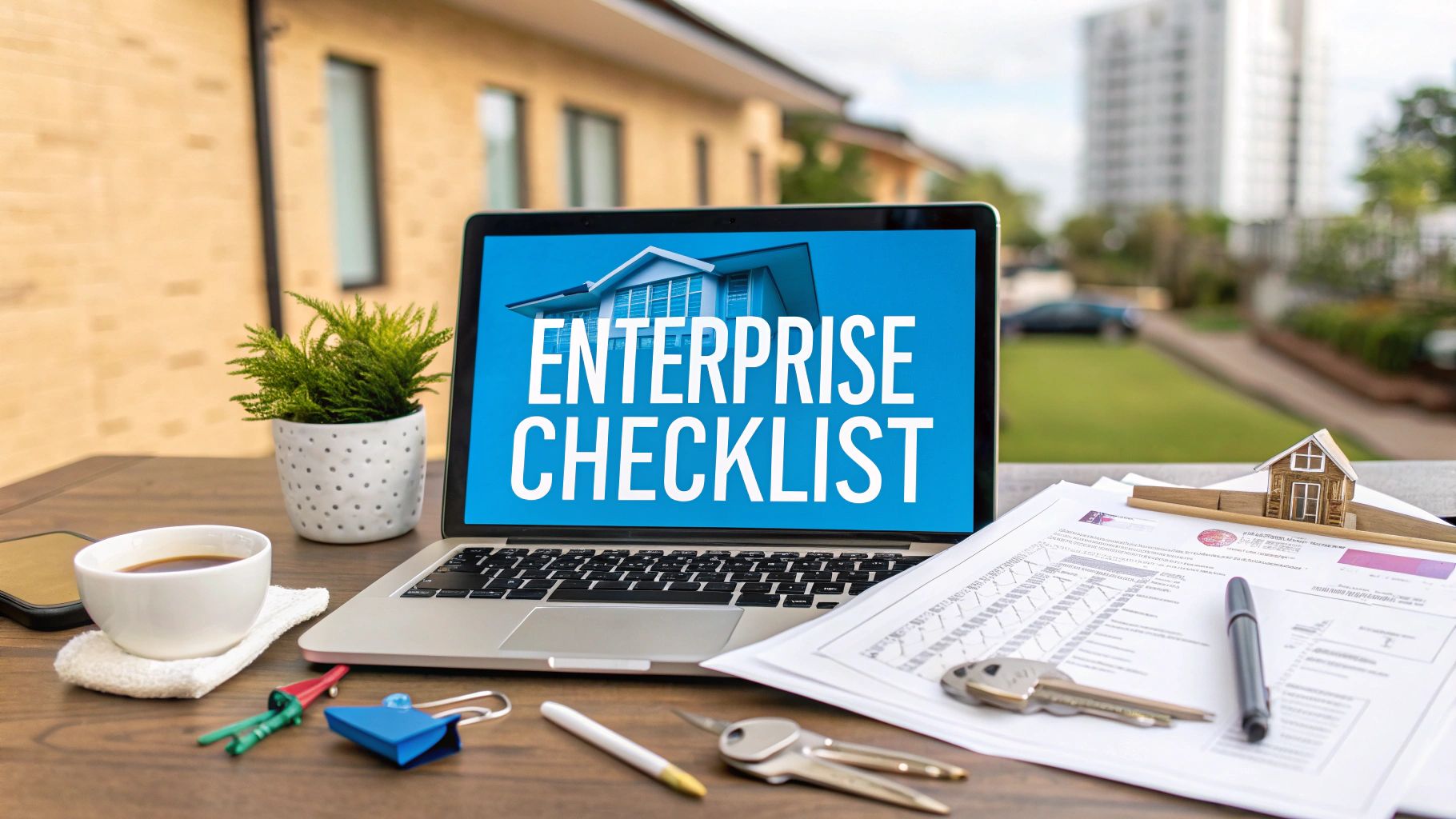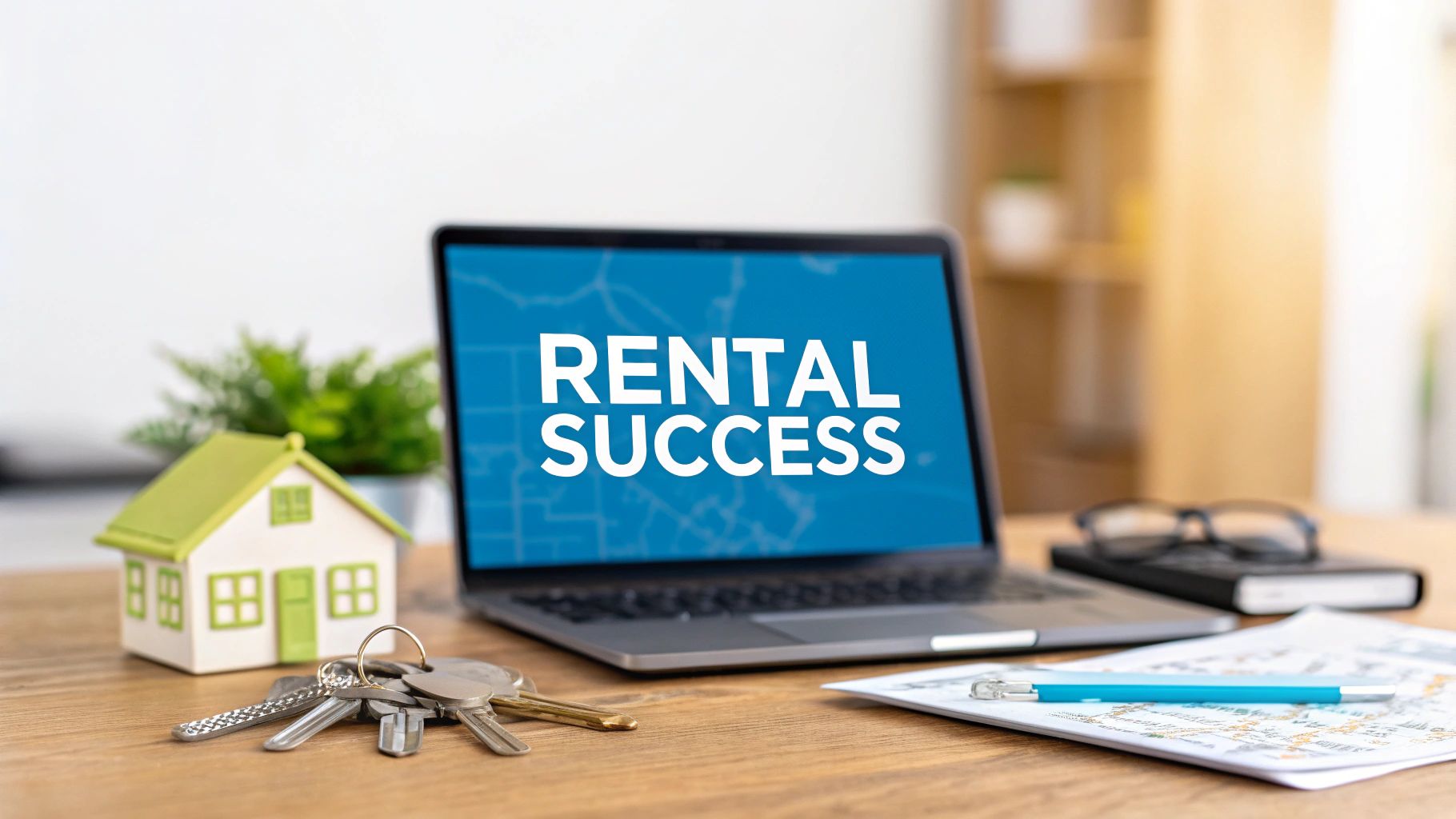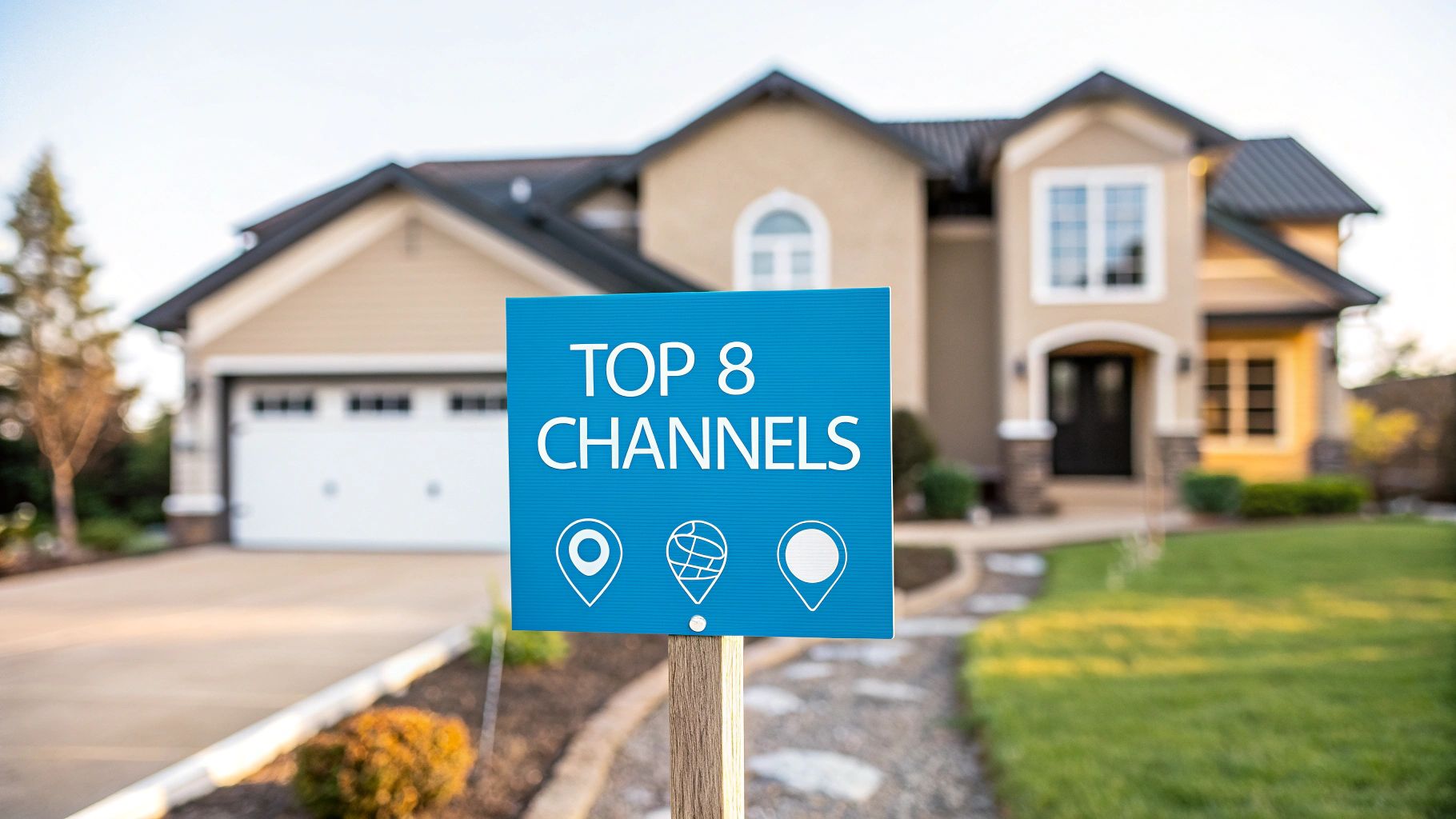Managing a portfolio of hundreds, let alone thousands, of distributed rental units transforms property management from a series of tasks into a complex operational challenge. Standard checklists often fail to address the immense pressure to reduce Days on Market (DOM), optimize lead-to-tour conversions, and drive down cost-per-door across a multi-market portfolio. For operations directors, every vacant day is not just a missed opportunity; it is a quantifiable revenue loss that multiplies with every unit.
A single extra vacancy day across a 1,000-unit portfolio with an average rent of $2,000 per month equates to a staggering $67,000 in lost revenue. This guide moves beyond basic to-do lists to offer a comprehensive property management checklist designed specifically for scale. It provides a strategic framework to systematize operations, leverage technology for remote management, and turn operational efficiency into a powerful competitive advantage.
This article details the seven critical pillars that large-scale property management companies must master. From tenant acquisition and screening to maintenance, financial management, and legal compliance, each step is broken down into actionable processes. By implementing this framework, you can standardize procedures across diverse portfolios, improve your speed-to-lease, and directly impact your bottom line. We will explore how to build repeatable systems that support growth, ensuring quality control and profitability whether you manage 100 units or 10,000.
1. Marketing and Tenant Acquisition
Effective marketing and tenant acquisition form the foundational first step in any successful property management checklist. This is not simply about posting a listing; it's a strategic process designed to minimize vacancy periods, which directly impacts revenue. For large-scale portfolios, this shifts from a one-off task to building a continuous lead pipeline where speed-to-lease is the most critical key performance indicator (KPI). Every hour a property sits vacant or a qualified lead waits for a response represents a quantifiable financial loss.
The primary goal is to attract a large pool of high-quality applicants quickly. This involves a multi-channel approach that maximizes visibility and a streamlined response system that converts interest into action. At an enterprise level, success is measured by lead-to-tour conversion rates and Days on Market (DOM). According to Zillow, over 50% of renters expect a response within 24 hours, but for high-intent leads, that window is much smaller. The first landlord to respond is often the one who secures the tour.
Actionable Implementation Strategy
To optimize your marketing and acquisition process, focus on three core areas: presentation, pricing, and process.
- Professional Presentation: High-quality visuals are non-negotiable. Invest in professional photography and 3D virtual tours (like those offered by Matterport). This allows prospective tenants to pre-qualify themselves and the property, leading to higher-intent tour requests.
- Data-Driven Pricing: Use property management software or tools like Zillow Rental Manager to analyze comparable properties (comps). Set a competitive price that reflects market demand, amenities, and property condition to attract serious applicants and reduce DOM.
- Automated, Rapid Response: The golden window for lead response is under 15 minutes. Implement automated responses via email or SMS to acknowledge inquiries instantly and provide a link to schedule a tour. This single process improvement can dramatically boost your lead-to-tour conversion rate. Platforms like RentSpree and PadMapper offer robust listing syndication, but pairing them with an automated scheduling system is key for scaled operations.
Ultimately, a superior marketing strategy not only fills vacancies but also enhances your company's brand reputation. While focusing on getting a lease signed is crucial, remember that the tenant experience begins at this first touchpoint. A seamless and professional acquisition process sets the stage for a positive landlord-tenant relationship, which can even simplify tasks later on, such as prioritizing tenant maintenance requests. A well-managed property from day one leads to happier, long-term tenants.
2. Regular Property Inspections
Systematic property inspections are a non-negotiable component of a comprehensive property management checklist, acting as a critical risk mitigation and asset preservation tool. This goes far beyond a simple move-in/move-out walkthrough. For large-scale portfolios, regular inspections are a proactive strategy to maintain asset value, ensure lease compliance, and identify minor issues before they escalate into costly capital expenditures. The primary goal is to shift from a reactive maintenance model to a preventive one, which directly protects the long-term ROI of each property.

The purpose of these inspections is multifaceted: verifying tenant care of the property, spotting unauthorized pets or occupants, and identifying potential safety hazards or deferred maintenance. At an enterprise level, consistency and documentation are paramount. Leading firms like Invitation Homes leverage drone technology for efficient, non-intrusive exterior and roof inspections on their vast portfolio of single-family rentals. Similarly, AvalonBay Communities conducts quarterly inspections using standardized mobile apps, ensuring every property across its 295+ communities is assessed against the same criteria. For property managers, having a structured approach to tenant screening is paramount. A valuable resource can be found in an ultimate lead qualification checklist that helps ensure only the most qualified applicants proceed.
Actionable Implementation Strategy
To implement an effective inspection program at scale, focus on standardization, technology, and legal compliance.
- Standardize with Digital Checklists: Eliminate variance and subjectivity by using digital inspection apps like Zumper or HappyCo. Create detailed, standardized checklists for different inspection types (e.g., move-in, quarterly, drive-by, move-out). This ensures every team member across any market assesses properties with the same objective criteria, from checking smoke detectors to looking for water damage under sinks. The importance of condition reports cannot be overstated, as they form the backbone of this process.
- Adhere to Legal Notice Requirements: Always provide tenants with proper written notice before entering a property, as specified by state and local laws (typically 24-48 hours). This not only ensures legal compliance but also maintains a positive and professional tenant relationship. Failing to do so can result in legal penalties and erode tenant trust.
- Leverage Time-Stamped Visuals: A picture is worth a thousand words in a dispute. Train staff to take high-resolution photos and videos of the property's condition, focusing on areas of concern, lease violations, or needed repairs. Modern inspection apps automatically timestamp and embed these visuals into the report, creating an irrefutable record for security deposit disputes or legal proceedings.
Ultimately, a robust inspection protocol is an insurance policy for your assets. It provides the data needed to make informed decisions about maintenance budgets, enforce lease terms, and protect the property's physical and financial health. This systematic oversight is a hallmark of a professional and scalable property management operation.
3. Maintenance and Repair Management
A structured system for maintenance and repairs is the operational backbone of any successful property management portfolio. This goes beyond simply fixing what's broken; it involves a proactive strategy to preserve asset value, control costs, and enhance tenant satisfaction. For large-scale portfolios, maintenance shifts from a reactive task to a critical cost-control and risk-mitigation function where First-Time Fix Rate (FTFR) and average ticket resolution time are key performance indicators. Unmanaged repairs lead to cascading failures, higher emergency expenses, and increased tenant turnover, directly eroding portfolio profitability.
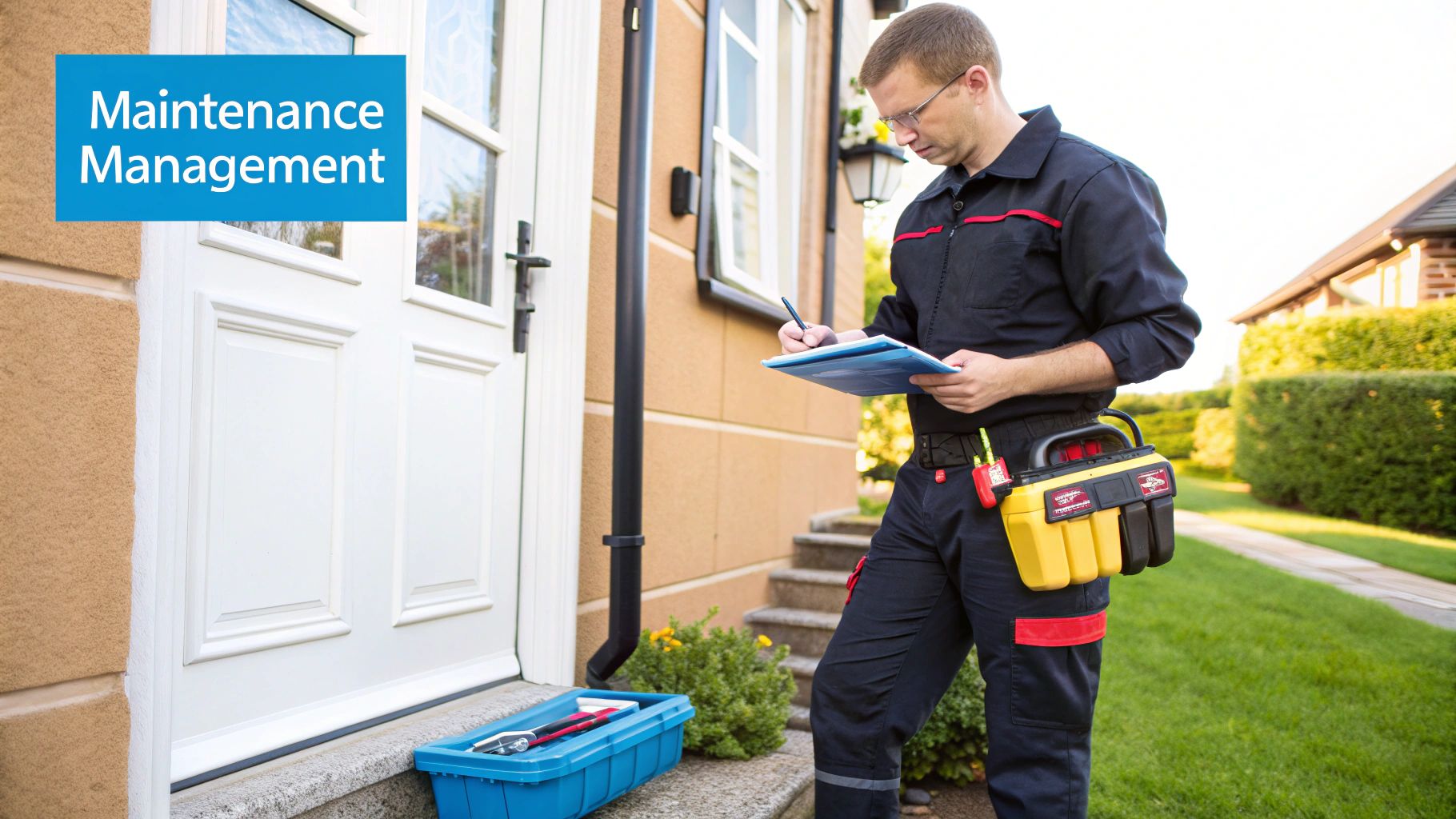
The primary goal is to transition from an expensive, emergency-based model to a predictive and preventive one. This requires a robust system for logging requests, dispatching vendors, and tracking work to completion. According to the 2022 NMHC/Grace Hill Renter Preferences Survey, maintenance quality is one of the top three drivers of lease renewals. Enterprise-level managers achieve high satisfaction by leveraging technology and standardized processes, building tenant trust and protecting the long-term value of each asset.
Actionable Implementation Strategy
To optimize maintenance operations, focus on three key pillars: systemization, vendor management, and proactive scheduling.
- Systemize with Technology: Implement maintenance management software to act as a central hub for all requests, work orders, and communications. Platforms like ServiceTitan or Maintenance Connection allow tenants to submit requests with photos, enable you to dispatch jobs to vendors, and track every step from submission to invoice. This creates a transparent, auditable record for every property.
- Establish a Vetted Vendor Network: Don't wait for an emergency to find a plumber. Build and maintain a list of pre-vetted, licensed, and insured contractors for all key trades (plumbing, HVAC, electrical, etc.). Regularly review their performance, pricing, and insurance credentials to ensure quality and compliance. This network is your first line of defense against costly delays.
- Implement a Preventive Maintenance Calendar: Create seasonal and annual checklists for crucial property systems. This includes tasks like HVAC servicing in the spring and fall, gutter cleaning, and roof inspections. Proactive maintenance is significantly cheaper than emergency repairs and extends the lifespan of major components like furnaces and air conditioners, maximizing their ROI.
Ultimately, a superior maintenance strategy is a powerful tenant retention tool and a critical component of your property management checklist. A well-maintained property justifies market rents and signals to tenants that their comfort and safety are priorities. When residents feel their concerns are addressed promptly and professionally, they are more likely to renew their lease. To further refine your approach, it's essential to understand how to effectively prioritize tenant maintenance requests to balance urgency with operational efficiency.
4. Rent Collection and Financial Management
Robust rent collection and financial management are the engine of a profitable rental portfolio, moving beyond a simple monthly transaction to become a core operational system. For enterprise-level managers, this process is about ensuring predictable cash flow and minimizing financial leakage across hundreds or thousands of units. The critical KPI here is the collection rate, where even a 1% improvement can translate into millions in recovered revenue annually. Every day that rent is delinquent represents not just a delay in cash flow but also an increase in administrative costs and potential eviction expenses.
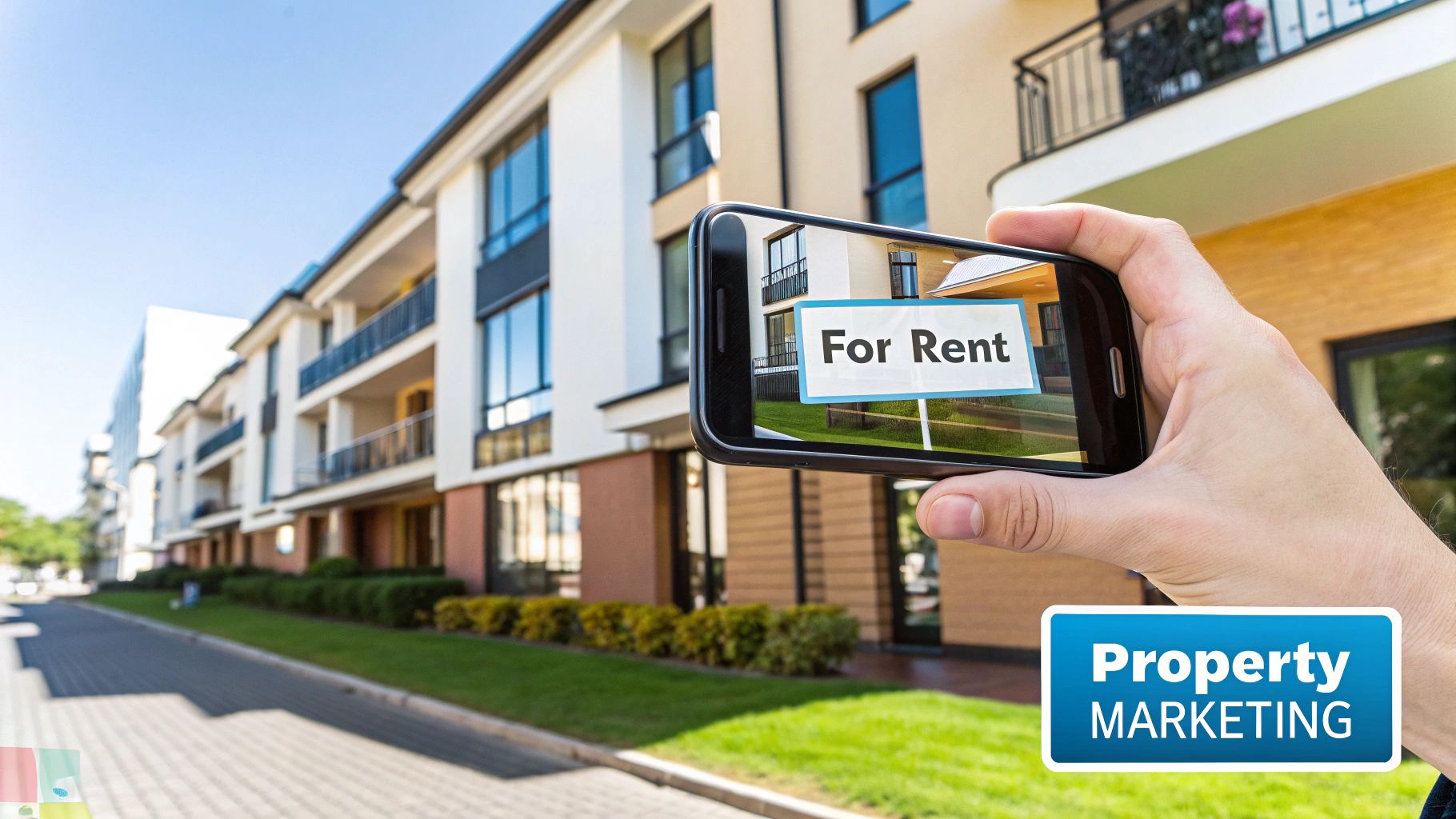
The goal is to create a frictionless, consistent, and legally compliant collection process that maximizes on-time payments. This requires a shift from manual tracking to automated systems that handle everything from payment reminders to late fee assessments. Leading REITs like UDR Inc. consistently achieve collection rates above 96% by leveraging sophisticated online payment platforms that offer tenants convenience and flexibility. Similarly, Mid-America Apartment Communities utilizes integrated software not only for collection but also for AI-powered rent optimization, ensuring financial performance is maximized at every turn.
Actionable Implementation Strategy
To streamline your financial operations, focus on systemizing payments, standardizing delinquency procedures, and maintaining pristine records.
- Offer Multiple Convenient Payment Options: Make it easy for tenants to pay on time by offering diverse digital payment methods. Platforms popularized by RentSpree or Cozy (now part of Apartments.com) allow for ACH transfers, credit/debit card payments, and even automated recurring payments. The easier you make it to pay, the lower your delinquency rate will be.
- Automate Late Fee Calculation and Notices: Manual late fee tracking is prone to errors and inconsistencies, creating legal risks. Use property management software to automatically calculate and apply late fees based on lease terms. The system should also trigger automated email and SMS reminders to tenants the moment a payment becomes overdue, ensuring consistent communication and a clear paper trail.
- Implement a Strict, Standardized Collection Procedure: Define and document a firm but fair collection timeline that is applied uniformly across all properties to ensure Fair Housing compliance. This procedure should outline when notices are sent, when phone calls are made, and at what point the eviction process is initiated. A non-negotiable process, guided by standards from organizations like the National Association of Residential Property Managers (NARPM), reduces disputes and improves collection efficiency at scale.
Ultimately, a superior financial management system is foundational to scaling a property management business. It not only secures revenue but also provides property owners with transparent, accurate financial reporting, building trust and justifying management fees. This systematic approach transforms rent collection from a reactive chore into a proactive, data-driven component of your complete property management checklist, directly impacting profitability and operational excellence.
5. Legal Compliance and Documentation
Navigating the complex web of real estate law is a critical, non-negotiable component of any property management checklist. This is not just about avoiding lawsuits; it’s about establishing operational integrity and protecting the portfolio from significant financial and reputational risk. For large-scale property management companies, legal compliance shifts from a reactive measure to a proactive, system-wide framework designed to ensure every action, from marketing to eviction, is defensible and uniform. Inconsistency is the biggest liability for a scaled portfolio, as a single compliance failure can create a precedent that jeopardizes operations across thousands of units.
The primary goal is to standardize legal processes to mitigate risk at every stage of the tenant lifecycle. This involves deep knowledge of federal (Fair Housing Act), state, and hyper-local ordinances that govern everything from security deposit handling to acceptable screening criteria. For enterprise-level operators, success is measured by the absence of fair housing complaints and the successful defense of any legal challenges. Industry leaders like Equity Residential maintain meticulous records and implement rigorous, ongoing training to ensure 100% fair housing compliance across its national portfolio. Similarly, AvalonBay Communities utilizes standardized, attorney-vetted lease agreements across all markets to ensure consistency and enforceability.
Actionable Implementation Strategy
To build a fortress of legal protection around your portfolio, focus on three pillars: standardization, documentation, and education.
- Standardized, Attorney-Reviewed Forms: Do not rely on generic online templates. Invest in lease agreements, addendums, and notices that are crafted or reviewed by a qualified landlord-tenant attorney specific to each state of operation. This ensures your documents are current with local laws and provide maximum protection. Use your property management software to deploy these standardized forms universally, preventing staff from using outdated or unapproved versions.
- Document Everything, Objectively: Every single tenant interaction, from a maintenance request to a noise complaint, must be logged in a centralized system with dates, times, and factual, emotion-free notes. This creates an unassailable record of conduct and decision-making. When denying an applicant, for example, the reason should be explicitly tied to pre-defined, uniformly applied screening criteria and documented in your system. This is your primary defense against discrimination claims.
- Mandatory, Recurring Training: The legal landscape is constantly changing. Implement a mandatory training schedule for all staff on key topics, especially the Fair Housing Act and local ordinances. Subscribing to updates from the National Apartment Association (NAA) or local real estate boards provides crucial information. Regular training, documented with attendance records, demonstrates a commitment to compliance and is a powerful mitigating factor in legal disputes.
Ultimately, robust legal compliance is the backbone that supports scalable growth. A single lawsuit can cost more than the annual revenue of several properties combined, making proactive legal diligence one of the highest-ROI activities in property management. By embedding legal best practices into your daily operations, you transform compliance from a burdensome task into a strategic asset that safeguards your portfolio and enables confident expansion.
6. Marketing and Tenant Acquisition
Effective marketing and tenant acquisition form a foundational step in any successful property management checklist. This is not simply about posting a listing; it's a strategic process designed to minimize vacancy periods, which directly impacts revenue. For large-scale portfolios, this shifts from a one-off task to building a continuous lead pipeline where speed-to-lease is the most critical key performance indicator (KPI). Every hour a property sits vacant or a qualified lead waits for a response represents a quantifiable financial loss.
The primary goal is to attract a large pool of high-quality applicants quickly. This involves a multi-channel approach that maximizes visibility and a streamlined response system that converts interest into action. At an enterprise level, success is measured by lead-to-tour conversion rates and Days on Market (DOM). According to Zillow, over 50% of renters expect a response within 24 hours, but for high-intent leads, that window is much smaller. The first landlord to respond is often the one who secures the tour.
Actionable Implementation Strategy
To optimize your marketing and acquisition process, focus on three core areas: presentation, pricing, and process.
- Professional Presentation: High-quality visuals are non-negotiable. Invest in professional photography and 3D virtual tours (like those offered by Matterport). This allows prospective tenants to pre-qualify themselves and the property, leading to higher-intent tour requests and reducing wasted time on unqualified showings.
- Data-Driven Pricing: Use property management software or tools like Zillow Rental Manager to analyze comparable properties (comps). Set a competitive price that reflects market demand, amenities, and property condition to attract serious applicants and reduce DOM. Accurate pricing is one of the fastest ways to improve leasing velocity.
- Automated, Rapid Response: The golden window for lead response is under 15 minutes. Implement automated responses via email or SMS to acknowledge inquiries instantly and provide a link to schedule a tour. This single process improvement can dramatically boost your lead-to-tour conversion rate. Platforms like RentSpree and PadMapper offer robust listing syndication, but pairing them with an automated scheduling system is key for scaled operations.
Ultimately, a superior marketing strategy not only fills vacancies but also enhances your company's brand reputation. While focusing on getting a lease signed is crucial, remember that the tenant experience begins at this first touchpoint. Regular maintenance is crucial for protecting your property's value, and this often includes specific upkeep like following essential roof maintenance tips. A seamless and professional acquisition process sets the stage for a positive landlord-tenant relationship, leading to happier, long-term tenants.
7. Emergency Preparedness and Response
A robust emergency preparedness and response plan is not a "nice-to-have" but an essential risk mitigation component in any professional property management checklist. For large-scale portfolios, the complexity multiplies; a single event like a hurricane, wildfire, or major system failure can impact hundreds of units and tenants simultaneously. This shifts the focus from reactive problem-solving to proactive, systemized contingency planning where response time and communication clarity are the most critical key performance indicators (KPIs). Every moment of indecision or misinformation during a crisis can lead to significant property damage, liability exposure, and a breakdown of tenant trust.
The primary goal is to minimize harm to people and property while ensuring business continuity. This requires a documented, multi-layered strategy that addresses various potential disasters. At an enterprise level, success is measured by the speed of vendor mobilization, the effectiveness of tenant communication, and the ability to maintain operational control. Industry leaders like the Bozzuto Group maintain 24/7 emergency response teams across their regions, while JBG SMITH leverages sophisticated emergency notification systems to broadcast critical updates to tenants instantly, a practice popularized by organizations like the Institute of Real Estate Management (IREM).
Actionable Implementation Strategy
To build a resilient emergency response framework, focus on three core areas: planning, communication, and resources.
- Create Detailed Response Protocols: Document step-by-step procedures for different scenarios (e.g., fire, flood, gas leak, security breach). These plans should include immediate actions, evacuation routes, and shutdown procedures. A key component of any robust property management checklist is ensuring readiness for unforeseen events. You can refer to an ultimate emergency preparedness checklist to ensure all bases are covered. Store these documents in a cloud-based system accessible to all team members from any location.
- Establish Pre-Vetted Vendor Networks: Do not wait for a disaster to find emergency contractors. Establish relationships with 24/7 plumbers, restoration companies (like Servpro or ServiceMaster), and electricians before you need them. Negotiate master service agreements (MSAs) for your portfolio to ensure priority service and pre-agreed rates, which is crucial when demand surges during a regional crisis.
- Implement a Tiered Communication System: Use property management software with mass messaging capabilities (SMS and email) to deploy instant alerts. Create pre-written templates for common emergencies to ensure messages are clear, concise, and accurate. The protocol should define who communicates with tenants, owners, and first responders to avoid confusion and conflicting information. Regular staff training and annual plan reviews are non-negotiable for ensuring this system functions under pressure.
Ultimately, a well-executed emergency plan protects your assets, tenants, and brand reputation. While day-to-day operations like tenant maintenance requests demand attention, it is the response during a crisis that truly defines a management company's competence and professionalism. Demonstrating preparedness builds immense trust and can be a deciding factor for tenants and owners when choosing a property manager.
7-Point Property Management Checklist Comparison
From Checklist to Competitive Edge: Automating Your Path to Profitability
Navigating the complexities of property management requires more than just a simple to-do list; it demands a robust, dynamic system. The comprehensive property management checklist we've detailed, covering everything from initial tenant acquisition to ongoing legal compliance, serves as the foundational blueprint for operational excellence. It breaks down the entire management lifecycle into seven critical pillars: Marketing and Tenant Acquisition, Tenant Screening, Regular Inspections, Maintenance Management, Rent Collection, Legal Compliance, and Emergency Preparedness.
However, for enterprise-level property management companies managing hundreds or thousands of distributed units, the true challenge isn't knowing what to do, but executing it all with speed, consistency, and efficiency at scale. Manually working through this checklist for a vast portfolio is a recipe for operational bottlenecks, increased Days on Market (DOM), and significant revenue leakage. The key takeaway is this: a checklist is a map, but technology is the vehicle that gets you to your destination faster and more profitably.
Shifting from Manual Execution to Systemized Automation
The transition from a reactive, manual approach to a proactive, automated one is what separates market leaders from the rest. Each item on your property management checklist represents a critical control point that can either drain resources or drive growth, depending on your operational model.
- Marketing and Tenant Acquisition: In a competitive rental market, speed-to-lease is paramount. Manual lead follow-up and tour scheduling create delays that allow high-quality prospects to find another property. Automating this top-of-funnel process ensures every lead is engaged instantly, maximizing your lead-to-tour conversion rate.
- Maintenance and Inspections: For remote portfolios, coordinating maintenance and conducting inspections without onsite staff is a logistical nightmare. Systemizing these processes with a network of on-demand field agents and a centralized platform transforms a major cost center into a streamlined, quality-controlled operation.
- Legal and Financial Compliance: Automation minimizes human error in critical areas like rent collection and documentation. Integrated financial systems ensure timely payments and accurate reporting, while digital document management secures lease agreements and compliance records, providing a clear audit trail.
The ultimate goal is to build a system where these checklist items are executed flawlessly with minimal human intervention. This is not about replacing property managers; it's about empowering them to focus on high-value strategic initiatives-like portfolio growth and owner relations-instead of being bogged down by repetitive administrative tasks.
The Financial Imperative: Connecting Your Checklist to the Bottom Line
Every item on the property management checklist has a direct or indirect impact on your portfolio's financial performance. The most significant lever for large-scale operators is reducing vacancy. Every day a unit sits empty, you lose revenue. Consider the math: for a property renting at $2,000 per month, each vacant day costs approximately $67. Across a portfolio of 1,000 units, even a small reduction in average DOM translates into hundreds of thousands of dollars in recaptured annual revenue.
By viewing your property management checklist through the lens of automation and scalability, you transform it from a defensive tool for avoiding mistakes into an offensive weapon for market domination. Mastering these seven pillars through technology allows you to create a predictable, repeatable, and highly profitable management engine. This is how the most successful property management companies are not just surviving but thriving, turning operational efficiency into their ultimate competitive advantage.
Ready to transform your property management checklist from a manual task list into an automated, revenue-generating engine? Showdigs streamlines the entire lead-to-lease process, from AI-powered scheduling to on-demand showings, helping you slash Days on Market and scale your operations effortlessly. See how leading property managers are automating their most critical checklist items by visiting Showdigs today.




